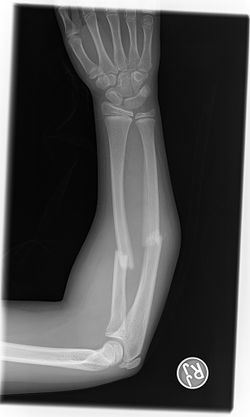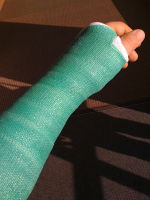Bone fracture
A Bone fracture is the breaking of a bone due to an excessive amount of stress being applied to the bone. Depending on the intensity and direction of force, a bone can fracture in several different ways. Depending on the severity of a fracture, there are two primary methods to treat it, one involving surgery, and one not. There are numerous dietary and lifestyle changes that can decrease one's chances of breaking a bone.
Types and Causes
In general, a bone fracture is caused when the bone is subjected to more force than the tissues composing it are capable of handling. The bone breaks under the stress, and depending on the location, type of stress, and force of the the stress, the bone will have a different type of fracture. All fractures can be sorted into two generalized categories: simple fractures (fractures in which all bones remain within the body), and compound fractures (fractures in which the broken bone penetrates the skin, exposing the bone and deep tissue to the external environment). Compound fractures are much more dangerous because they present a higher risk of infection. Doctors often prescribe antibiotics to patients with compound fractures[1].
Bone fractures are identified by more than simply compound or simple fractures. The angle, direction, and power of force to the bone all contribute to the type of fracture. Bone fractures are categorized as comminuted, greenstick, avulsion, transverse, oblique, spiral, or impacted fractures[1][2].
Comminuted Fracture- In a comminuted fracture, the bone is broken into many fragments.[1]
Greenstick Fracture- In a greenstick fracture, the bone breaks on one side from a perpendicular force to the length of the bone. These fractures are only seen in children, whose bones have not completely ossified and therefore bend and partially break rather than breaking completely.[1]
Avulsion Fracture- These fractures occur when an extreme force applied to a ligament or tendon rips a small piece of bone from the rest of the bone. Avulsion fractures can occur when muscles are overworked or suddenly pulled.[1]
Transverse Fracture- Transverse fractures are a break on the x axis of the bone and occur excessive force is applied perpendicular to the length of the bone.[1]
Oblique Fracture- Oblique fractures are angled breaks in the bone that result from force applied from any direction other than perpendicular to the length.[1]
Spiral Fracture- These occur when a bone experiences a severe twisting force.[1]
Impacted Fracture- An impacted fracture occurs when the bone breaks into two or more pieces that are then driven into each other.[2]
Treatment
Bone fractures in appendages (arms or legs) typically require first aid treatment of a splint to prevent the limb from moving. These splints must be made of something rigid such as wood, metal or plastic, padded with gauze and then wrapped with rolled gauze to apply pressure. [3]
In order for a bone fracture to heal properly, the bone must be positioned into its correct area, in a process called reduction. There are two types types of reduction: closed reduction and open reduction. In a closed reduction setting of a bone, the bone is moved into the correct position without surgery. The majority of fractures in children are treated with through the process of closed reduction[3]. In closed reduction, a splint or cast is used to prevent movement and allow healing to occur. A patient typically only wears a cast for a few weeks while the bone(s) heals.[4]
In an open reduction setting of a bone, the fracture requires a surgery to position the bone. The site of the fracture may need to be held together with implements such as pins, plates, screws, rods, and glue[3]. Each of these tools are used to prevent the bone or bone fragment from moving, and therefore healing incorrectly[4]. Once the opening has been thoroughly cleaned and disinfected to prevent infection, it is stitched closed and then immobilized in a splint or cast. Following the surgery, a patient is usually prescribed antibiotics, and once the cast is removed the limb must have a time period of about four to six weeks to regain strength[3].
Prevention
Although there is no way to guarantee that one will never fracture a bone, there are several lifestyle and dietary changes that you can use to increase bone density and lower your risk of a break.
Studies have shown that smokers typically have lower bone densities than those who do not smoke. These studies record that the risk of a fracture increases with the amount of cigarettes and amount of time a person has smoked, and when a smoker breaks a bone, it takes him longer to heal than a non-smoker. Quitting smoking can increase bone density, but it may take several years to build the bones up and decrease the risk of a fracture. Although smoking does significantly affect the bone densities, many people who smoke have other lifestyle and dietary habits such as failing to exercise and drinking alcohol which contribute to the risk.[5]
In order build up bone density and lower the risk of fracturing a bone, one should consider the following.[5]
Quit smoking- As stated above, smoking increases risk of fractures, and quitting can lower the odds.[5]
Intake high amounts of calcium and vitamin D- As children, most people are told to drink milk to build strong bones. Dairy products contain calcium, a mineral necessary for the hardening of bones. Vitamin D is necessary for the calcification process, as it absorbs calcium to be used for fortifying the skeleton.[5]
Exercise- Exercise, in addition to strengthening muscle, helps to build up bones, reducing the chances of a fracture.[5]
Avoid excessive use of alcohol- Excessive alcohol skews the body’s calcium balance. In addition, it affects the production of hormones that protect the bones.[5]
Video
This video discusses the different types of bone fractures.
References
- ↑ 1.0 1.1 1.2 1.3 1.4 1.5 1.6 1.7 Taylor, Tim. Types of Bone Fractures InnerBody. Web. Accessed 13 October 2015.
- ↑ 2.0 2.1 What is Impacted Fracture Ygoy. Web. Accessed 13 October 2015. Author unknown.
- ↑ 3.0 3.1 3.2 3.3 Understanding Bone Fractures -- Diagnosis and Treatment WebMD. Web. Accessed 22 October 2015. Author Unknown
- ↑ 4.0 4.1 Healthgrades Editorial Staff. Fracture Treatments Healthgrades. Web. Accessed 22 October 2015.
- ↑ 5.0 5.1 5.2 5.3 5.4 5.5 Smoking and Bone Health NIH. Web. Published April 2015. Author Unknown.
| ||||||||||||||||||||




